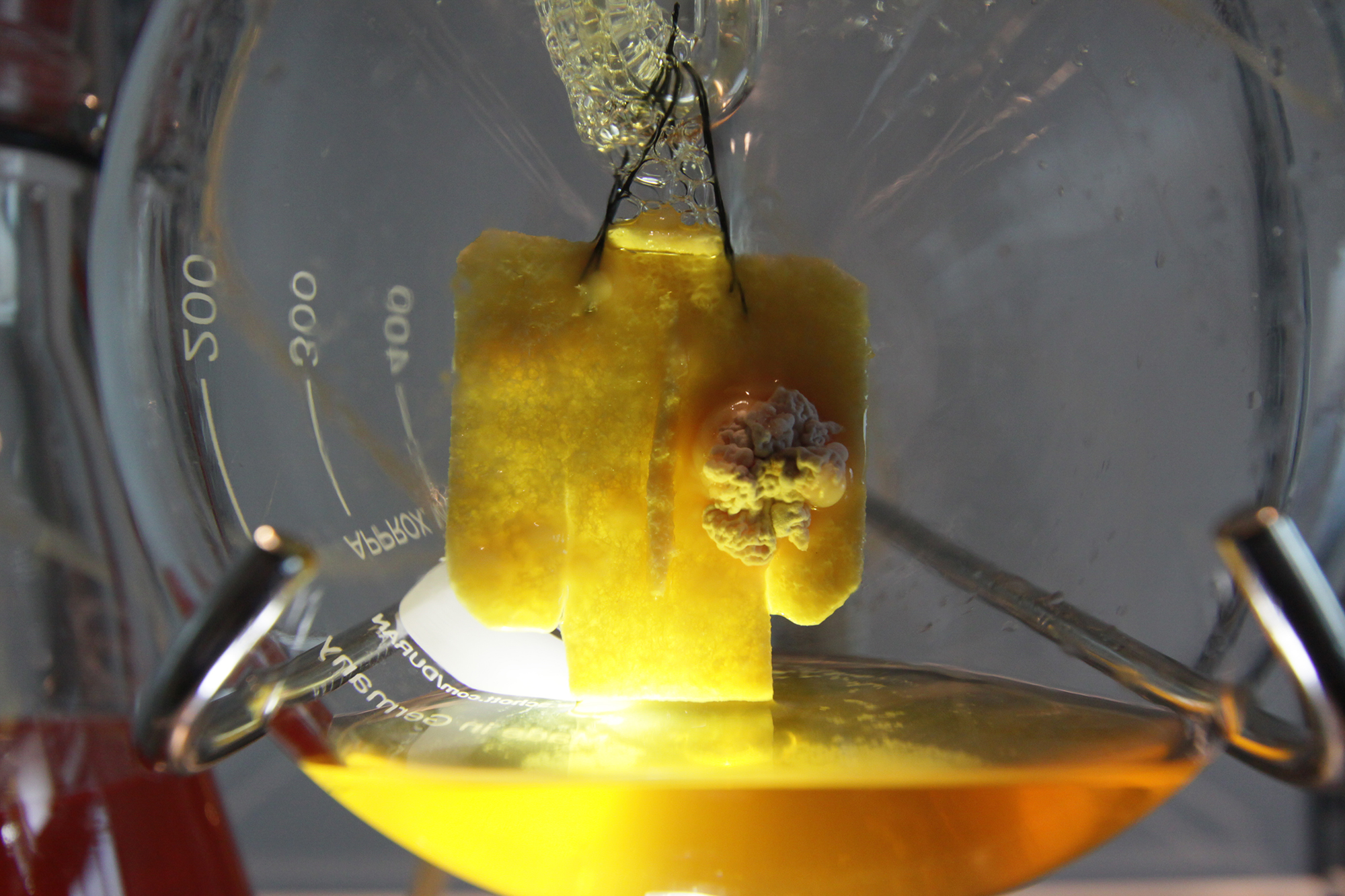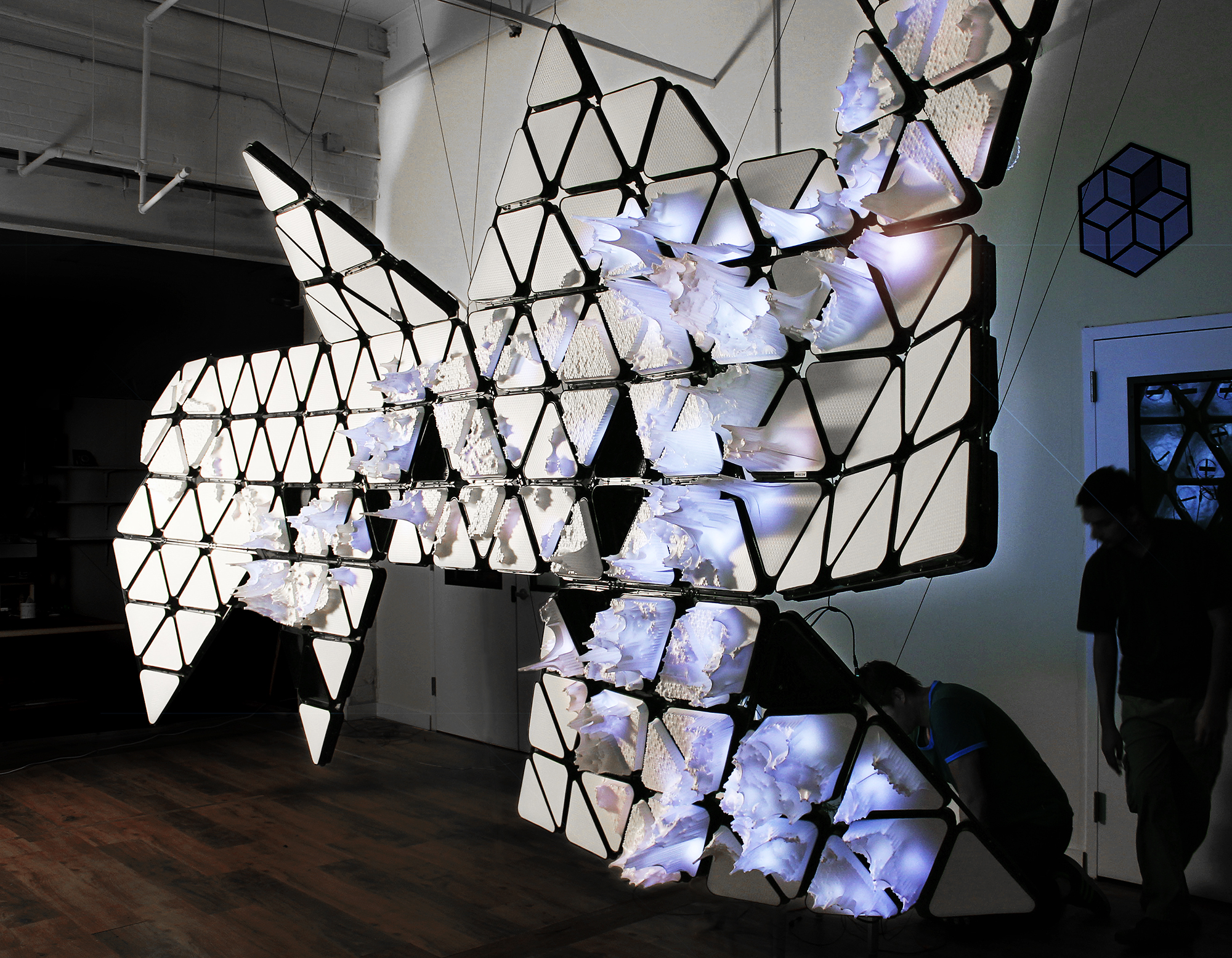
“Victimless Leather” was an art project by Catts and Ionat Zurr, who use living tissue as their medium of choice. In this case, they grew a miniature coat of cells inside a custom-made perfusion chamber; the project was exhibited at the Museum of Modern Art in New York.
 Super Cells is the new TED Book by Nina Tandon and Mitchell Joachim, who take us on an eye-popping tour of the tantalizing array of inventions already being created with nature’s elemental building block, the cell. They argue that we’re entering a new technological revolution, one in which we can create smarter technologies by making cells our partners in design. In the excerpt below, Joachim explains why life provides such a compelling material for artists forging the brand new field of “bioart.”
Super Cells is the new TED Book by Nina Tandon and Mitchell Joachim, who take us on an eye-popping tour of the tantalizing array of inventions already being created with nature’s elemental building block, the cell. They argue that we’re entering a new technological revolution, one in which we can create smarter technologies by making cells our partners in design. In the excerpt below, Joachim explains why life provides such a compelling material for artists forging the brand new field of “bioart.”
The old adage that art imitates life has been officially subverted. Now art literally is life.
In a handful of unconventional labs and studios around the globe, artists and scientists are hybridizing their expertise to create a whole new form: bioart. Their materials are living cells, proteins, tissues, and DNA. Their tools include electrodes, centrifuges, incubators, and sterile test tubes.
The purpose is to explore the possible expressions of life, manipulated, and to challenge us to consider the implications of manipulating life in the first place.
Consider the creations of SymbioticA, a lab/studio at the University of Western Australia that is among the field’s most trailblazing pioneers. For the semipermeable (+) exhibit at Powerhouse Museum in Sydney in summer 2013, bioartists Guy Ben-Ary, Kirsten Hudson, and Mark Lawson created a piece based on the technology of induced pluripotent stem cells (iPS cells). Their piece was entitled “In Potentia.” The technique they used (based on Nobel prize–winning science) was to take non-stem cells (e.g., foreskin cells) and re-program them into an embryonic-like state (sort of like “cellular amnesia”) by applying a cocktail of genes to them. Induced pluripotent stem cells have generated a lot of interest because, like embryonic stem cells, they can be directed into different lineages, like neuron, muscle, bone, etc., but without the controversy that comes with being derived from embryonic tissue. In this case, the bioartists reprogrammed foreskin cells into iPS cells. Then they directed the differentiation of the cells into neurons and grew them into neural tissue that generated neural impulses. The artists encased this “biological brain” in a custom sculptural incubator, complete with a life-support system, an electrophysiological device, and a custom-made electrophysiological recording setup consisting of an array of micro-electrodes that measured neural activity. (They developed this in collaboration with Backyard Brains; see co-founder Greg Gage’s TED Talk about making a “beatbox” from cockroach electrophysiological recordings.) The electrical pulses were then converted into digital signals and linked to a musical tone that sounded like a haunting soundscape. The goal? As the artists said, it’s to challenge “Western culture’s fetishization of consciousness” by transforming foreskin cells into a “brain.”
Another bioartist in the same exhibit, Andre Brodyk, derived a code sequence of 158 DNA bases from the human gene APOE4 (Apolipoprotein E4). He was particularly interested in this specific gene because mutations in it have been associated with late-onset Alzheimer’s disease. Brodyk used this sequence, along with a gene for a glowing protein, to transform E. coli bacteria. “Transformation” is a process by which some bacteria take up foreign genetic material (naked DNA) from the environment. Not all bacteria are capable of taking up exogenous DNA from their environment, so Brodyk used the BL21 strain, which is known to transform with high efficiency. Brodyk used the transformed bacteria to draw red glowing images that gradually deteriorate and fade over time, in reference to the pattern of memory loss seen in many who suffer from late-onset Alzheimer’s disease, in which people tend to accurately recall things from the distant past but have difficulty recalling things in the immediate past.
“I’m an artist, I’m a storyteller,” explains SymbioticA cofounder and director Oron Catts. As the “gap that makes most of us uneasy” between our cultural perceptions of life and what we are able to do to it through technology widens, Catts wants people “to be confronted and challenged.”
Catts and Ionat Zurr, his wife and fellow artist, have been experimenting in bioart for nearly two decades. They launched SymbioticA’s progenitor, the Tissue Culture and Art Project, in 1996. That project’s provocative works have included Pig Wings, three tiny sets of wings grown from pig-bone-marrow stem cells; experiments with lab-grown meat; semi-living “worry dolls,” which were the first tissue-engineered sculptures to be exhibited live in a gallery context; and Victimless Leather (exhibited at the Museum of Modern Art), a miniature coat grown of cells inside a custom-made perfusion chamber. Living tissue is their medium — one that, given the right signals and nourishment, can grow into prescribed, fantastical forms.
Catts and Zurr are artists, but it was science that spurred them to this imaginative action. In 1997, a startling and unsettling image spread across the news. Researchers at the University of Massachusetts Medical School had grown cow cartilage cells into the shape of a human ear and implanted it onto a mouse’s back. The mouse’s blood vessels nourished the appendage, and the result looked like a horribly deformed mouse that had sprouted a human ear on its back. (The researchers later used similar techniques to grow replacement bones for patients’ missing thumbs and a new chest plate for a boy born without cartilage or bone on his left side.)
“When we saw this image it was quite amazing for us,” Catts recalls. “One reason was because we’d reached that degree of treating life as a sculptural form, and also [because] it was ethically quite challenging.” Catts and Zurr decided that as artists they needed to participate in this radical redefinition of life, contribute to it, and subvert it.
SymbioticA — where resident artists and researchers collaborate within an academic biology department — was born in 2000. The lab/studio’s genre-bending identity blends the advantages of both art and science, freeing each from classic constraints. Here, artists use the trappings of biologists not only to reference and comment upon scientific ideas, but also to actively investigate their potentials. Researchers, for their part, pursue “curiosity-based explorations, free of the demands and constraints associated with the current culture of scientific research,” as the SymbioticA website explains.
So what does a creation such as Pig Wings do? It raises questions about the authorship and creation of life. At what point is art that has been created out of live mammalian tissue actually alive? Is it any portion of a person’s complex living parts that defines “life,” or is it only a cohesive sentient body? Do humans have the moral certitude to deconstruct life-based organisms into disparate fragments for the sake of science? Or art?
Bioart itself raises ethical questions, which Catts and Zurr acknowledge. They endeavor to make the death of the artwork a public experience, and to implicate the audience in the killing. We mess with life all the time, Catts suggests, but with art, we can take the time to think about what that really means.
Fundamentally, bioartists deliver an opportunity for the general public to approach the otherwise mysterious realm of genetic alterations and bioengineering. This invitation is essential, as many people have little comprehension of the intense bioethical disputes that happen chiefly in secluded meetings, in which private interests tend to win out over the needs of everyday people. Coaxing the public into an in-depth discussion of these issues is critical for the integrity and welfare of humanity — and for our prospects of using these dazzling technological developments well.

The Bio City Map of 11 Billion displays the world population density in 2110 as a three-dimensional graph, on which the data are displayed in the form of bioluminescent E. coli bacteria. Designed and created by Mitchell Joachim and his team at Terreform ONE.
According to many census sources, in the next 100 years we can expect the human population to reach 11 billion. Is this sustainable? At Terreform ONE, I started a data-visualization art project that directly confronts life and the human population’s impact on the planet: the Bio City Map of 11 Billion. Highlighting the 25 densest cities on Earth, it displays the world population density in 2110 as a three-dimensional graph, on which the data are displayed in the form of bioluminescent E. coli bacteria, plotted and grown inside petri dishes. We modified the bacteria with DNA that encodes fluorescent proteins found in sea anemones and jellyfish.
So, clustered across the map, glowing red E. coli under UV light represent future population projections, while green E. coli represent existing conditions in cities. We combined practices from biology (a dilution method to control the range of densities of E. coli populations in each petri dish) and architecture (stencils derived from CAD files that shaped the bacteria into specific geometries to display the current conditions), as well as cartography and urban planning. Meanwhile, on the back of the map, we used a photographic technique called bacteriography to underscore the zones of highest growth.
The map combines all the world’s cities together as one continuous growth system. As the human population expands, we see it as one single macro city spread across the continents. The project argues that most nations cannot view the effects of planetary population density through the lens of just one city or region; instead we aim to reveal the long-range effects of massive human population in areas of present and future urban intensity.
Rather than using computer code to mimic growth in nature, our method embodies the actual iterative vehicle of growth itself. Bacteria in this constrained form and under the right conditions behave almost identically to urban population patterns. In time, the mapping installation may illustrate patterns yet unobserved in typical digital computer models. It is this emergent and unfettered map of population that we wish to make into a spectacle. By using biolab-based materials, we expect to narrow the gap between idealized mathematical interpretations and observable events in nature.
While bioartists and designers undoubtedly aspire to bring the mostly inaccessible circles of science to the layman’s conversation, I suspect that there’s another factor that motivates their work: It is very satisfying to work in the medium itself. After all, this is one of the first new mediums to become accessible in centuries, along with video and computational art. I can only suppose that numerous Northern Renaissance painters felt likewise when they were first exposed to innovative oil paint colors and textures.
What will our successors do with the palette of life?
Read much more in the TED Book, Super Cells: Building with Biology. It’s available for the Kindle, Nook, and through the iBookstore. Or download the TED Books app to get access to this title — and the entire TED Books archive — for the duration of your subscription.
Comments (9)
Pingback: Design Domain – part 1 – Jenny Coyle Ixd
Pingback: A Multidisciplinary Analysis of Green-Bioprinting Methods & Design Principles – Visual 2 Digital
Pingback: 7 ways to have fun with DNA | Health & Wellness Chicago
Pingback: How to grow a bone without a body | Health & Wellness Chicago